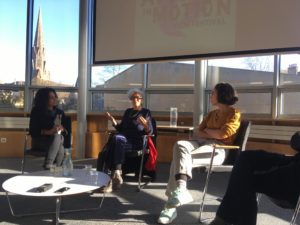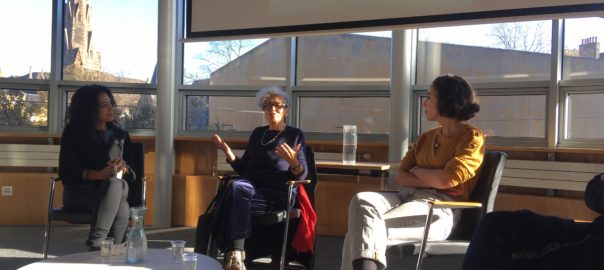On Sunday 28 October 2018, as the midday sun was starting to dispel the morning fog and entering the tall windows of our conference room, we convened a meeting of formidable Moroccan women: Farida Benlyazid, filmmaker who also was the first woman producer in Morocco (when she produced Jillali Ferhati’s A Breech in the wall, 1977); Lamia Chraibi, producer extraordinaire of, among other transnational films, Narjis Nejjar’s Stateless (2018), Hicham Lasri’s Jahilya (2017), Oliver Laxe’s Mimosas (2016); and Sofia El Khyari, whose short animation Ayam (2017) has won many international awards and was screened on Tuesday 30 November as part of the Africa in Motion film festival in Scotland.

The speakers had different takes on the complex question of Moroccan women’s cinema, its history, its situation today (we noted a sharp increase in the number of women filmmakers since the late 1990s), and how complicated it was to enter and find one’s place as a woman in the world of cinema in Morocco. Farida Benlyazid reminded her audience, however, that Moroccan cinema has had female participants from the start[1], as illustrated by the presence of two of them at the very first national film festival in Morocco: Farida Bourquia as director and Farida Benlyazid as producer.
Lamia Chraibi first credited les grands (great filmmakers) – in particular Narjis Nejjar – for her ability to gradually find her “place” in the Moroccan world of cinema, as she created her own niche in transnational film production. Then she described her work as a woman producer in Morocco not so much as a challenge as an achievement, to be reached through lots of hard work, of course, but also through will power accompanied by a unique sense of exhilaration when working on beautiful, worthwhile projects.
Sofia El Khyari identified a similar irrepressible drive to work in cinema that propelled her forward with such urgency that it helped her convince herself as well as her family that animation, her true calling, was the only career she could possibly embrace. The three women agreed that the minuscule number of women in key positions in the institutions of Moroccan cinema found a variety of explanations, and that upward mobility in the sector was only possible for women from the upper classes, who were educated and usually had studied abroad, even if, of course, there were notable exceptions to this unspoken rule.
Once the background picture of women in cinema had thus been laid out, the round table welcomed a lively dialogue with the audience, replete with shared questions and comments from practitioners of cinema in Morocco and elsewhere (e.g. Nadir Bouhmouch or Hakim Belabbes, as well as Lidia Peralta), Moroccan academics and critics (e.g. Rachid Naïm or Hamid Aïdouni), postgraduate students (e.g. Lamyâa Achary or Amine Belabbes). The status of women in Morocco’s contemporary society was discussed as well as the sharp divides that exist amongst women as to how they reacted to the reform of the personal code – the mudawwana – in 2004: some of them demonstrated against it, seeing it as erring away from the message of the Quran, while others applauded the rights it conferred on women.
The immense divide between the (remote) rural areas and the urban centers was also evoked as one of the primary factors that slowed down the awareness of young girls. Of particular interest were the exchanges on integrated misogyny on the one hand and on the various interpretations and consequences of the #MeToo movement in Morocco, on the other. Again, issues around education broadly construed were used to explain the low percentage of women able to produce films, and the small number of women occupying decision-making positions in the institutions of cinema, who could affect the present and future of Moroccan cinema. In particular, participants lamented not only the lack of schooling that accounts for the high rate of illiteracy among girls and women in the kingdom, but also the role-models offered by mothers who raise their daughters at home to serve their fathers and brothers; what little girls see on TV; what women see in Moroccan films. In the end, Lamia Chraibi asked: “what do we[filmmakers and producers] give the audience to see?”
The discussion thus laid bare a variety of paradoxes such as: filmmakers need to make films that will reach (entertain?) their audience while also playing a more proactive, political part in raising consciousness in Moroccan women and men; if the hitherto red lines of class and gender seem to be slightly blurrier and able to be transgressed by young determined young women, the structure of the cinema-making apparatus has not moved an inch; a prerequisite for women to enter the world of Moroccan cinema still seems to entail leaving Morocco to study and/or gain experience abroad.
Perhaps what was most heartwarming in this roundtable was the openness of the dialogue and the quality of the listening by every participant to their interlocutors. The conversation went on informally over lunch afterwards, as little clusters formed, shared stories and laughed.
[1]In that early postcolonial Moroccan cinema is not unlike early French cinema (e.g. Alice Guy-Blaché was a filmmaker from 1896 on; Germaine Dulac who wrote about film at the turn of the century, directed her first one in 1915…).
Flo Martin
